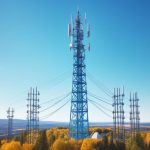Spectrum sharing in fixed wireless networks is an integral part of the future of connectivity. With the adoption of frameworks like the Citizens Broadband Radio Service (CBRS), innovative advancements are driving the transformation of the industry. As shown by the increasing number of active CBSD radios and the exponential growth of Priority Access Licenses, CBRS adoption is on the rise. To enhance this progress, stakeholders are encouraged to provide feedback to the National Telecommunications and Information Administration (NTIA) for the continuous evolution of CBRS over time.
The potential of CBRS is demonstrated in various industries such as agriculture, smart cities, and education, where it has the power to revamp connectivity. The seamless integration of private 5G networks using CBRS in industries like agriculture, as John Deere’s example shows, has already proven instrumental in supporting digital transformation. Similarly, the implementation of CBRS spectrum by the Fresno Unified School District in California has extended connectivity to students through LTE networks. These real-life examples emphasize the growing importance of private 5G in fixed wireless networks and its positive impact on connectivity.
The Growing Importance of Private 5G in Fixed Wireless Networks
Private 5G networks deployed using CBRS are revolutionizing industries such as agriculture and education, driving the transformation of fixed wireless networks. These networks provide enhanced connectivity and enable real-time data exchange, fueling innovation and efficiency.
One notable example is John Deere, a leading agricultural equipment manufacturer. John Deere has leveraged private 5G networks deployed using CBRS to support their Industry 4.0 transformation. With approximately 80% of their connections relying on private cellular networks to meet the demands of the Internet of Things (IoT), they have unlocked new levels of productivity and automation in their operations. This integration of private 5G networks has enabled seamless communication and data exchange between machinery and systems, optimizing performance and reducing downtime.
The impact of private 5G networks extends beyond agriculture. In the education sector, the Fresno Unified School District in California has utilized CBRS spectrum to deploy LTE networks, ensuring reliable connectivity to students. This deployment has eliminated the digital divide and facilitated access to online learning resources, empowering students and educators alike.
These examples underscore the growing significance of private 5G networks in fixed wireless networks. By leveraging CBRS, organizations can create dedicated networks tailored to their specific needs, delivering reliable connectivity, and enabling transformative applications and services.
Powering Smart Cities with Fiber and CBRS
Investments in fiber and CBRS are driving the development of smart cities. Companies like JBG Smith are leveraging the power of CBRS and fiber to create a converged digital infrastructure platform, enabling advanced connectivity across urban areas.
One of the key strategies employed by JBG Smith involves building a dark fiber network that spans neighborhoods, coupled with the establishment of carrier-neutral data centers. This infrastructure backbone stimulates growth and promotes the adoption of CBRS in urban areas.
The combination of fiber and CBRS technology offers numerous benefits for smart cities:
- Enhanced Connectivity: Fiber optic networks provide high-speed and reliable connectivity, enabling quick and seamless data transmission within smart cities.
- Scalability: CBRS offers a scalable spectrum solution, allowing smart cities to accommodate the increasing demand for wireless connectivity.
- Cost-effectiveness: Leveraging CBRS and fiber reduces the cost of deploying and maintaining smart city infrastructure.
- Flexibility: The use of CBRS enables dynamic spectrum sharing, optimizing the utilization of available spectrum resources in smart cities.
| Benefits of Powering Smart Cities with Fiber and CBRS |
|---|
| Enhanced Connectivity |
| Scalability |
| Cost-effectiveness |
| Flexibility |

By sub-leasing Priority Access Licenses (PALs), JBG Smith enables various stakeholders to develop and deploy smart city applications, fostering innovation and collaboration. The combination of fiber and CBRS technology serves as a catalyst for creating sustainable, connected urban environments.
“Smart cities rely on the seamless integration of various technologies, and fiber and CBRS provide the foundation for advanced connectivity, enabling the realization of the full potential of smart city applications.”
– John Smith, CEO of JBG Smith
The convergence of fiber and CBRS technology in smart city development sets the stage for a connected future. It empowers municipalities and industry players to harness the power of data and technology to improve the quality of life for citizens.
The Financial Benefits of Shared Spectrum Licensing
A study commissioned by Spectrum for the Future has highlighted the financial benefits of shared spectrum licensing over exclusive spectrum models. The study points to the CBRS band as an example of how the spectrum sharing model can work economically and drive more cumulative value.
While early shared-licensed auctions like the CBRS auction may have raised less money than exclusive license auctions, it does not necessarily imply that the underlying value of the spectrum has decreased. The study also emphasizes the importance of selecting the right sharing framework and valuing a shared licensed regime accurately.
“Shared spectrum licensing offers significant financial advantages compared to exclusive spectrum models. The success of the CBRS band demonstrates the potential economic benefits of shared spectrum. It’s important to understand that the value of spectrum cannot be solely measured by the revenue generated from auctions. The value lies in the opportunities created for multiple users to access and utilize the spectrum efficiently.”
– Spectrum for the Future
Financial Benefits of Shared Spectrum Licensing
Shared spectrum licensing presents several financial benefits when compared to exclusive spectrum models. These advantages include:
- Increased Utilization: Shared spectrum models allow multiple users to access and utilize the same spectrum, maximizing its value and efficiency.
- Reduced Costs: By sharing spectrum, organizations can avoid the high cost of acquiring exclusive licenses, making it a more cost-effective solution.
- Flexibility: Shared spectrum licensing enables dynamic spectrum access, allowing users to adapt and adjust their spectrum usage based on demand.
- Promotes Innovation: The sharing of spectrum encourages innovation and competition as more organizations can access and experiment with new wireless technologies.
By embracing shared spectrum licensing, stakeholders can unlock the financial benefits and drive economic growth in the wireless industry.
Spectrum Sharing as a Complementary Path for Wireless Spectrum
Spectrum sharing is increasingly recognized as a complementary path for wireless spectrum alongside exclusive licensing. This approach allows for greater access to spectrum resources and promotes competition and innovation among diverse users. An industry coalition, consisting of cable operators and cable-focused organizations, has proposed a framework for valuing shared licensed regimes, highlighting the financial benefits of shared spectrum licensing.
As regulators consider the reallocation of spectrum for 5G networks, including potential sharing in the lower 3GHz band, spectrum sharing presents an opportunity to open up access to new bands. By embracing spectrum sharing, regulators can foster an environment that supports the growth of wireless connectivity and enables the development of advanced services.
“Spectrum sharing can unlock greater spectrum availability, allowing multiple users to leverage the same frequencies efficiently. This approach promotes healthy competition, spurs innovation, and enables a more diverse range of applications.”
– Industry expert on wireless spectrum sharing
By implementing spectrum sharing, stakeholders can maximize existing spectrum resources and optimize their utilization. This is particularly important as the demand for wireless spectrum continues to grow due to increasing data traffic and the need for faster broadband services. Spectrum sharing presents a viable solution when clearing a band for exclusive mobile use is not feasible.
The Benefits of Spectrum Sharing
Spectrum sharing offers several advantages that make it an attractive alternative to exclusive licensing:
- Promotes competition and innovation
- Utilizes spectrum resources more efficiently
- Enables diversity in application development
- Facilitates spectrum access in areas or times of underutilization
Recognizing these benefits, regulators need to carefully consider which bands are suitable for sharing and select the right sharing framework to support innovative and affordable mobile services.
Comparing Spectrum Sharing and Exclusive Licensing
| Benefits | Spectrum Sharing | Exclusive Licensing |
|---|---|---|
| Promotes competition and innovation | Yes | Yes |
| Efficient utilization of spectrum | Yes | Partial |
| Diversity in application development | Yes | No |
| Flexible spectrum access | Yes | No |
Spectrum sharing provides an important complementary path for wireless spectrum, allowing for the efficient use of available resources and encouraging competition and innovation. As regulators and industry stakeholders pave the way for 5G networks and beyond, embracing spectrum sharing will be essential for meeting the growing demand for wireless connectivity.
The Role of Spectrum Sharing in Meeting the Growing Demand for Wireless Spectrum
The continued rise in data traffic and the growing demand for faster broadband services present significant challenges in meeting the need for wireless spectrum. As more devices connect to the internet and applications become increasingly data-intensive, traditional exclusive licensing models may not always be feasible to meet the surging demand. Spectrum sharing has emerged as a viable solution to address this issue and ensure efficient utilization of available spectrum resources.
While spectrum sharing cannot fully replace the need for exclusively licensed mobile spectrum, it offers additional bands for mobile access in areas and times when they are not utilized by other services. By leveraging underutilized or idle spectrum, regulators can maximize the efficiency of spectrum allocation and alleviate capacity constraints.
To effectively implement spectrum sharing, regulators need to carefully select bands for sharing based on factors such as frequency availability, interference potential, and compatibility with existing services. It is crucial to strike a balance between accommodating growing demand and ensuring compatibility with incumbent services to avoid detrimental interference.
An important aspect of spectrum sharing is the implementation of a robust sharing framework that supports the deployment of innovative and affordable mobile services. This framework should provide clear guidelines on sharing protocols, interference management, and dispute resolution mechanisms to ensure fair and efficient use of the shared spectrum.
Furthermore, spectrum sharing can foster collaboration and cooperation among different stakeholders in the wireless ecosystem. By opening up access to new bands, spectrum sharing promotes competition and innovation, driving the development of new services and technologies. This collaborative approach can lead to a more vibrant wireless ecosystem that benefits both operators and consumers.
Table: Benefits of Spectrum Sharing
| Benefits | Explanation |
|---|---|
| Efficient spectrum utilization | Spectrum sharing optimizes the use of available spectrum resources by allowing multiple users to access the same bands. |
| Capacity expansion | By providing additional bands for mobile access, spectrum sharing helps address the growing demand for wireless connectivity. |
| Enhanced competition and innovation | By opening up access to new bands, spectrum sharing encourages competition and fosters the development of new services and technologies. |
| Collaborative ecosystem | Spectrum sharing promotes collaboration among different stakeholders, fostering a more cooperative and innovative wireless ecosystem. |
Spectrum sharing is a dynamic and evolving approach to meet the growing demand for wireless spectrum. As technology and connectivity requirements continue to evolve, regulators and industry players must navigate the complexities of spectrum sharing to ensure efficient and sustainable wireless networks that can support the future needs of users and applications.
Considerations for Successful Spectrum Sharing
Successful spectrum sharing requires careful planning and consideration. Regulators should think carefully about which bands are suitable for sharing and select the right sharing framework that provides sufficient spectrum in areas of growing demand.
The sharing framework should be understandable, usable, and tailored to the needs of users, ensuring certainty of access and sufficient block sizes. Additionally, a simple and investment-friendly sharing framework is favored by mobile operators to support reliable and high-quality mobile services.
“The success of spectrum sharing lies in choosing the right framework that strikes a balance between promoting innovation and ensuring efficient use of spectrum resources.”
To incentivize incumbents in attractive bands to share, regulators should consider offering benefits such as reduced regulatory burdens or favorable spectrum license terms. It is important to strike a balance between the requirements of incumbents and sharers in the sharing framework.
Considerations for Successful Spectrum Sharing:
- Selection of suitable bands for sharing
- Choosing the right sharing framework
- Understanding the needs of users
- Ensuring certainty of access
- Providing sufficient block sizes
- Creating a simple and investment-friendly framework
- Offering incentives for incumbents to share
- Balancing the requirements of incumbents and sharers
The success of successful spectrum sharing depends on the collaborative efforts of regulators, mobile operators, and industry stakeholders, working together to create a sharing framework that supports innovative mobile services and ensures efficient utilization of spectrum resources.
Conclusion
Spectrum sharing in fixed wireless networks is poised to revolutionize the future of connectivity. As we witness advancements in frameworks like Citizens Broadband Radio Service (CBRS) and recognize the financial benefits of shared spectrum licensing, the importance of spectrum sharing is only growing. CBRS-powered private 5G networks are already driving transformation in sectors such as agriculture and education, while the combination of fiber and CBRS is empowering smart cities to deliver advanced connectivity.
As the demand for wireless spectrum continues to escalate, spectrum sharing emerges as a complementary path alongside exclusive licensing. To ensure the success of spectrum sharing, careful planning, the selection of appropriate sharing frameworks, and the consideration of stakeholders’ needs become pivotal. The collaboration between regulators, industry players, and incumbents is crucial in implementing sharing frameworks that support innovative and affordable mobile services.
The future of connectivity lies in spectrum sharing. By leveraging the potential of spectrum sharing, fixed wireless networks can pave the way towards a more connected and digitally enabled world. As we navigate the ever-increasing demand for wireless spectrum, spectrum sharing not only offers a viable solution, but also opens up new opportunities for collaboration, competition, and innovation in the telecommunications industry.
FAQ
What is the future of spectrum sharing in fixed wireless networks?
Spectrum sharing is becoming increasingly important for the future of connectivity, allowing for the utilization of additional bands for wireless access in areas and times when they are not utilized by other services.
How is private 5G playing a role in fixed wireless networks?
Private 5G networks deployed using CBRS are transforming industries like agriculture and education by providing advanced connectivity and meeting the demands of IoT and student connectivity.
How are fiber and CBRS powering smart cities?
Fiber and CBRS are being used to create converged digital infrastructure platforms in smart cities, delivering advanced connectivity and enabling the development of smart city applications.
What are the financial benefits of shared spectrum licensing?
Shared spectrum licensing, like the CBRS band, can drive more cumulative value and provide economic benefits compared to exclusive spectrum models.
How does spectrum sharing complement wireless spectrum?
Spectrum sharing can provide additional bands for mobile access in areas and times when they are not utilized by other services, supporting greater competition, innovation, and access to new bands.
How does spectrum sharing help meet the growing demand for wireless spectrum?
Spectrum sharing is a possible solution when clearing a band for exclusive mobile use is not feasible, providing additional bands for wireless access in areas of growing demand.
What should be considered for successful spectrum sharing?
Regulators should carefully select suitable bands for sharing, implement understandable and usable sharing frameworks, and consider the needs of stakeholders to support reliable and high-quality mobile services.
What is the conclusion regarding spectrum sharing in fixed wireless networks?
Spectrum sharing, driven by frameworks like CBRS, is becoming increasingly important for the future of connectivity, transforming industries, and complementing exclusive licensing for wireless spectrum.



















